

Malta’s history and heritage
Since Neolithic times, for over 8,000 years, Malta has been populated and remains of the earliest inhabitants can still be found on the island. The large structures of Neolithic temples are still standing in the south of the island of Malta (Tarxien Temples, Hagar Qim, Mnajdra), and in Gozo (Ggantija).
Scientists reckon that some of these temples were erected around one thousand years before the construction of the famous pyramids of Giza in Egypt, and are believed to be the oldest free-standing monuments in the world. After the Neolithic culture faded away, around 2,000 B.C., the island was conquered by the Phoenicians, Carthaginians, Romans and Arabs respectively.
During the Middle Ages, Malta was involved in the Byzantine-Arab Wars and was invaded by the Arabs, who introduced new irrigation, some fruits and cotton to the island. The Arabs also brought over the Siculo-Arabic language from Sicily, to which Malta was closely affiliated at the time. The language would eventually evolve into current-day Maltese. The Arabs allowed the native Christians to practice their religion but were discriminated against by being charged with an extra tax.
The Normans seized Malta around 1091, and were welcomed by the native Christians, who will have been pleased to see Roman-Catholicism reintroduced as the state religion. The Maltese islands became part of the Kingdom of Sicily, which also covered a large part of present-day Italy.

The Order of Knights of St John (also known as the Knights of Malta) ruled the islands from 1530 until 1798, during which period they built present-day capital city Valletta . ( Learn more about Valletta’s history here. )
The Knights improved living conditions across the Island building hospitals, stimulated trade and commerce and erected strong fortifications. During their rule, the Knights successfully held out for many months throughout the horrific fighting and massive assaults by Ottoman invaders, now coined The Great Siege of 1565.
In 1798 Napoleon’s army conquered the island, easily removing the Knights of St John from power, who had not been prepared for the force with which the French charged. In the six days that followed the conquest, a civil code was laid down for Malta. Slavery was abolished and all Turkish slaves were freed. Napoleon himself created a primary and secondary education system and a more scientific based university replaced the old one.
The British Throne took over Malta after Napoleon’s demise and ruled the islands for the next 160 years. Malta was bombed persistently by German forces during World War II in an attempt to take over the Malta, which was known as a location of high strategic importance for both trade and conflict. Malta was bombed more heavily in 1942 than the whole blitz of London. The British and Maltese unified in their battle for survival and the Germans failed to conquer neither Malta, nor the Maltese.
The determination and strong spirit shown by the population of Malta led King George VI to award Malta the George Cross. His official message, which was engraved in a marble plaque on the façade of the Presidential Palace in Valletta, reads: “To honour her brave people I award the George Cross to the Island Fortress of Malta, to bear witness to a heroism and a devotion that will long be famous in history.” This award is still part of the national flag of Malta and is seen as a symbol of a proud nation. The Maltese gained their independence from the British in 1964 and the country would continue as a sovereign state and republic. Since May 2003, Malta is a member of the European Union and a popular tourist destination for many Europeans.
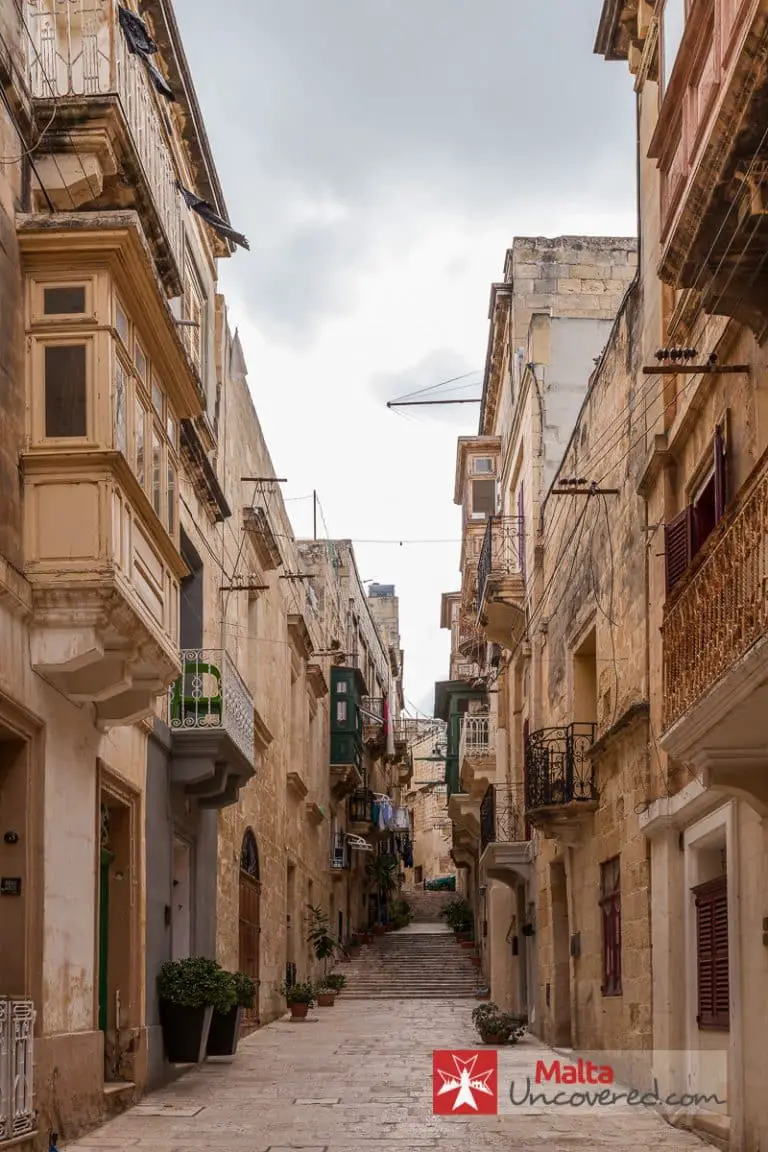
Timeline of Malta’s history
B.c. – pre-history and classical malta (5000-218 b.c.), a.d. – classical and medieval malta (60-1530), the knights of st. john (1530-1798), the french occupation (1798-1800), the british period (1800-1964), independent malta (1964-to date).
- Berg, Warren G. Historical Dictionary of Malta . Maryland, US: The Scarecrow Press, Inc. 1995. Miscellaneous other publications
- Timeline originally compiled by Martin Debattista and published on AboutMalta.com
- https://vatican.com/The-Lateran-Treaty/
Was this article helpful? Share it with your friends!

Edward est le fondateur et l'éditeur de Malta Uncovered, et l'auteur de deux guides sur Malte et La Valette.
En tant que touriste devenu expatrié avec des racines maltaises, il connaît parfaitement les îles et aide chaque année des milliers de visiteurs à profiter d'un voyage mémorable.
I recently spent time in Malta, living in an apartment in Floriana, whilst I got to know a little more about this petit, attractive and vibrant country. I love the warm honey coloured limestone, used in the sixteenth century buildings. Such Charm! Your History Timeline is most interesting and appreciated, by one who wanted to learn a little more of Malta’s History. I am not Maltese, however I now have an affection for this fascinating place.
Happy to hear Rob! Floriana is a fascinating place, both to stay as well to explore and I’m planning on providing a guide for it soon!
You did a wonderful job writing this article. Very interesting and educational. Thank you
My parents with their six girls arrived in Australia in August 1951 but I have always been proud of my wonderful heritage. I love my adopted country. The spirit of the Lighthorsemen but I still call myself a Maltese and am not ashamed to be one.
I am so proud to be part of Malta’s heritage. This article is a wonderful depiction of Malta’s history. Born in Canada to 2 Maltese parents I hope to keep your wonderful traditions alive! Thanks so much for the insight.
Leave a Reply Cancel reply
Your email address will not be published. Required fields are marked *
Yes, I would like to receive emails from you with Malta travel tips.
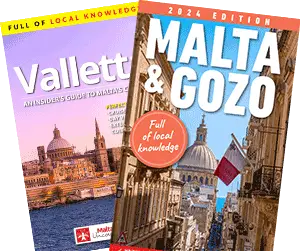
Get the most out of your visit to Malta with Malta Uncovered guidebooks – full of local knowledge and up-to-date for 2024 !
© 2006-2024 Malta Uncovered. All Rights Reserved.
- Taxi Booking
- Excursion and tours
- Maltese History Timeline
- Maltese Historical Civilizations
- Middle Ages
- The Great Siege, Knights of Malta and Napoleon
- British Malta and World War II
- Malta’s Independence and Republic
- The culture of Malta through history
- Religion in Malta
- Maltese politics
- Maltese Folklore
- Weather and Climate
- Top 10 cities in Malta
- Getting to Comino
- Getting to Gozo
- Did you know?
- General Information
Top City according Members
The best "did you know" according members, the culture of malta explained , a mixture of societies of cultures over long centuries.
The culture of Malta is the result of the many different societies that came in contact with the Maltese Islands throughout history, including cultures of neighbouring countries, cultures of nations that ruled Malta for long centuries, and other influences from tourism and media.
The culture of modern Malta is a rich one, composed of traditions, beliefs and practices that resulted out of a long process of adaptation and assimilation of different societies over time. Subjected to these historic processes, the Maltese culture also incorporated the linguistic and ethnic admixture that defines who the Maltese people are.
The Maltese culture of today can be effectively defined as being Latin European with influences from the British period of history quite evident. Arab influences are very apparent in the Maltese language and perhaps a bit in the Mediterranean diet, but they’re not seen anywhere else. Latin European influences remain predominant mainly because of the island’s rulers in the past eight centuries as well as the fact that Malta shares religious beliefs and many traditions with its Sicilian and Southern European neighbors.
Semitic influence
Malta was inhabited by the Phoenicians from around 700 BC who exploited the shelter of Malta’s harbours. By 480BC, as Carthage was growing its empire in the Western Mediterranean, Malta became a Punic colony. Exposure to semitic influences continued to an during the 268-year rule of the Knights of St. John, in part because of trade, but mainly because of the large numbers of slaves present in Malta during the 17th and 18th centuries.
Dramatic incidents related to piracy and slavery remain with us till today, reflected in Maltese folklore, superstitions, beliefs, sayings and in the Maltese literature, with works such as Inez Farrug written by Anton Manwel Caruana in 1889 (1889) and the traditional ballad of l-Gharusa tal-Mosta, which narrates the kidnap of a Maltese bride by Turkish pirates.
Influences of Catholicism on Maltese culture
It is said that in Malta, Gozo, and Comino there are around 365 churches; or one church for every day of the year. Every town has its parish church as the focal point and a main source of civic pride. This pride is beautifully manifested during festas; celebrating the day of the patron saint of each parish with marching bands, processions, fireworks and other festivities.
According to tradition, and as recorded in the Acts of the Apostles, the Church in Malta was founded by St. Paul in 60AD, following his shipwreck on these Islands. The earliest Christian place of worship in Malta is known to be St. Paul's Grotto – the place where St. Paul was imprisoned during his stay on Malta. Evidence of Christian practices and beliefs during Roman persecution can be found in the many catacombs that lie underground around Malta. There are also a number of cave churches, including the grotto at Mellieħa, where St. Luke is said to have painted a picture of the Madonna.
Under the rulings of the Norman, Spanish and the Knights, Malta became the devout Catholic nation it is today. It is worth noting that the Inquisition had a very long history in Malta – established by the Pope in 1530, with the last Inquisitor departed in 1798, after the Knights surrendered to the forces of Napoleon Bonaparte.
Influences of migration
Malta’s position as a maritime nation paved the way for extensive interaction between Maltese seamen and their colleagues around the Mediterranean. Moreover, by the mid-19th century, the Maltese had already a history of migrating to other places, including Egypt, Greece, Sicily and other islands in the Mediterranean. Intermarriages where quite common, while migrants would return to Malta from time to time, importing new customs and traditions that been absorbed into mainstream Maltese culture as time went by.
Migration was heavy once again after World War II, where around a third of the Maltese population left to start a new life in faraway lands, namely Australia, Canada, UK and US. In the 1990s many Maltese and second generation migrants returned to Malta. Recent years have seen an increase in the number of foreign expatriates moving to Malta, creating an increasingly cosmopolitan environment in the towns and around Malta.
A few basics of the Maltese culture:
- The Maltese culture is a combination that comes alive by different societies that interacted with the Maltese people over time. Read about how the Maltese culture was influenced by each ruler in the history of Malta.
- The Maltese are a very devout Catholic nation, and religion still has an important place in the modern Maltese society. Read about Religion in Malta
- Maltese people spend a lot of time and energy discussing politics. Especially as the general elections draw closer.
- The Maltese language is the only semitic language written in Latin Alphabet.
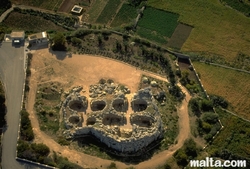
| About us | Contact us | Advertise on Malta.com | Terms and Conditions |
Copyright © 2011 - 2019 All rights reserved in all formats known and unknown.
Malta.com is held by an independent commercial company, not related to any civic or official institution. Malta.com was created to promote the Island of Malta. We provide information about Malta, Gozo and Comino - Malta guide, Attraction, Event, Museum, Beaches, Hotels, Apartments and Farmhouses.
Malta.com is powered by a private technical solution - Contact us for more information.
You must activate Javascript support in your browser settings.
Created on April 15, 2021
Presentation of Malta
More creations to inspire you
A trip through portugal, news video presentation, cactus video presentation, pride month, traveling europe, recycling paper video presentation, types of music video presentation.
Discover more incredible creations here
Maltese and...
What language is spoken in Malta?
MALTA IS IN EUROPE Its capital is Valletta, which is the smallest national capital in the European Union
Where is Malta?
The culture of Malta reflects various societies that have come into contact with the Maltese Islands throughout the centuries, including neighbouring Mediterranean cultures
Culture of Malta
Languages of Malta
Malta is a tourist destination with its warm climate, numerous recreational areas, and architectural and historical monuments, including three UNESCO World Heritage Sites: Ħal Saflieni Hypogeum, Valletta,and seven megalithic temples which are some of the oldest free-standing structures in the world.

Discover the power of visual creativity with our unique Malta templates for PowerPoint, Canva and Google Slides. Transform your presentations and stand out from the crowd. Our extensive catalog includes everything from the imposing fortifications of Malta’s capital city to the enchanting coastline of Gozo, providing everything you need to highlight your activities. Elevate your presentations with high-quality statistical graphics, evocative images and a rich variety of content that reflects Malta’s cultural and historical diversity.
With our templates, every aspect of Malta becomes the main focus, ideal for sharing projects or narrating travel experiences. Take advantage of our innovative creations to incorporate a unique and sophisticated touch to your presentations. Immerse your audience in Malta’s rich history and captivating visual landscape, ensuring that every presentation is a memorable and deeply impactful experience.

Free Malta Templates for PowerPoint and Google Slides
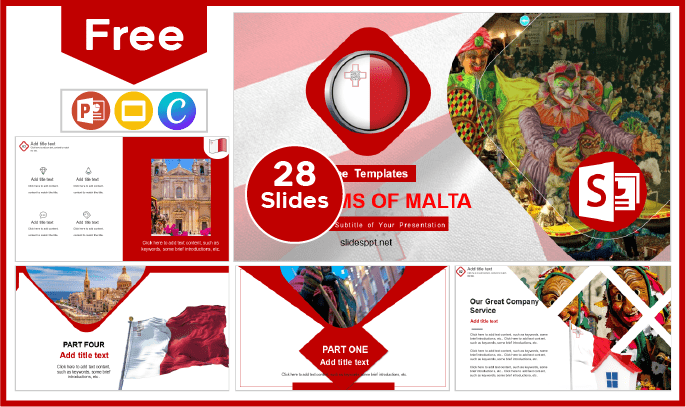
Malta Customs Template

Malta Tourism Template
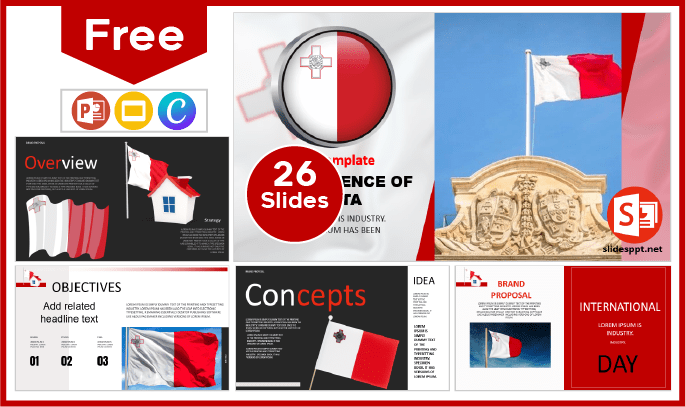
Malta Independence Template

Malta Gastronomy Template
We use cookies to improve the experience of everyone who browses our website. Cookies Policy
Accept Cookies
Malta PowerPoint Map Template
The Malta PowerPoint Map Template presents the geographical aspects of Malta through interactive visual maps. The presenter can use this template to showcase Malta’s tourist attractions, businesses or discuss location vise subjects. It brings the attention of audience by using geographically relevant icons.
Malta, an archipelago island country which has 3 large islands with rocky coasts. It is a small country filled with interesting activities including boats, yachts and vacation cruises. Beautiful sea views, beaches and deep-sea scuba diving. Cities are crowded with local craft markets and restaurants. To demonstrate all these interests, users can take a maximum advantage of this PowerPoint Template. This presentation is also suitable for those who have or want to propose business in Malta. For instance, pin mapping cities to display sales territories, business, office or franchise location, travel plans and much more.
The main slide in the Malta PowerPoint Map Template shows a country chart with location pointers and round flag design. There are three slides with editable side text fields to add presentation points. The template carries several slides with different customization in shape design. These customization includes change in color, mapping pins, drawing with and without cities. Two slides have assorted styles to show a closer look at Malta’s capital city Valletta. It gives audience an opportunity to easily visualised several cities like Valletta.
This high-quality PowerPoint Presentation is created to display map locations and geographical details of Malta. The maps are vector based and 100% editable. It means, color, size and shading can be modified for effective presentation. The users can highlight cities for business figures by changing color or adding number on cities.
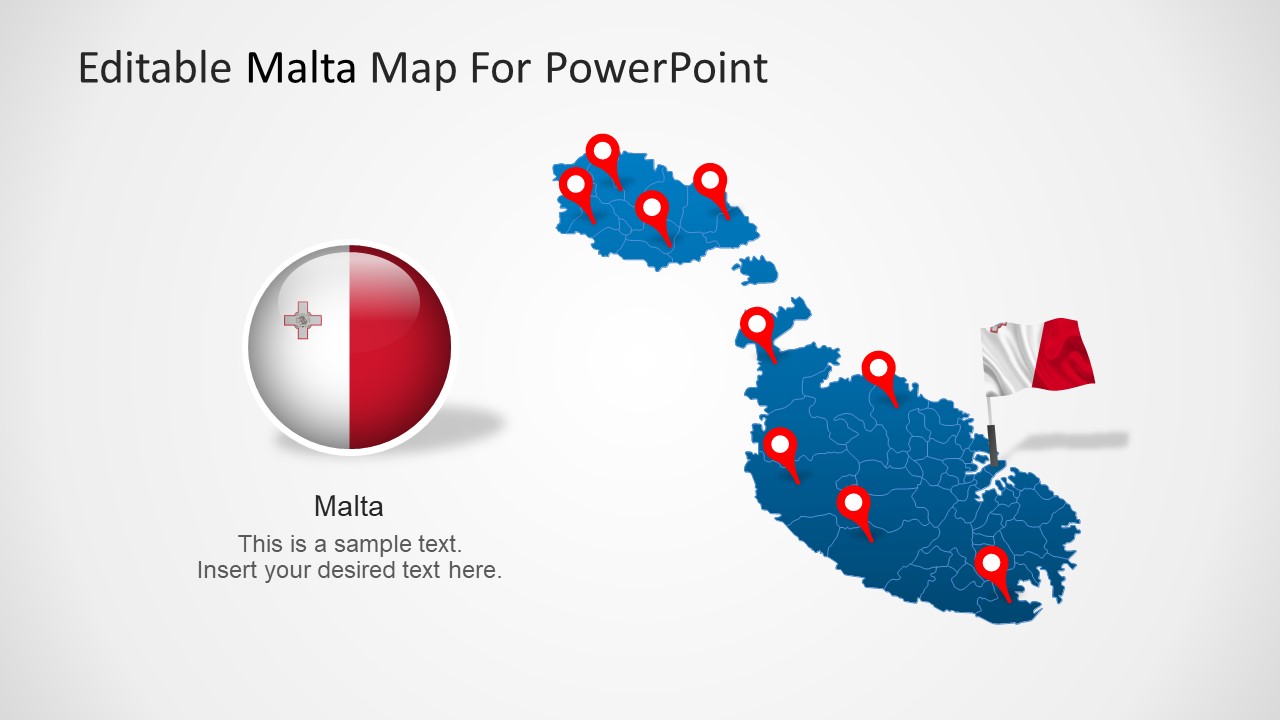
You must be logged in to download this file.
Favorite Add to Collection

Subscribe today and get immediate access to download our PowerPoint templates.
Related PowerPoint Templates
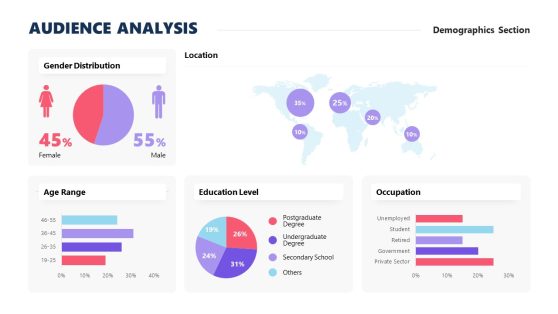
Audience Analysis PowerPoint Template
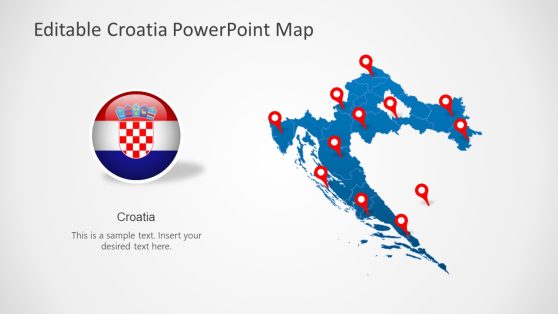
Editable Croatia Map Template for PowerPoint
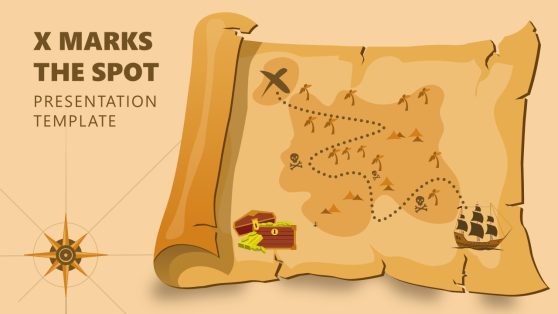
X Marks the Spot PowerPoint Template
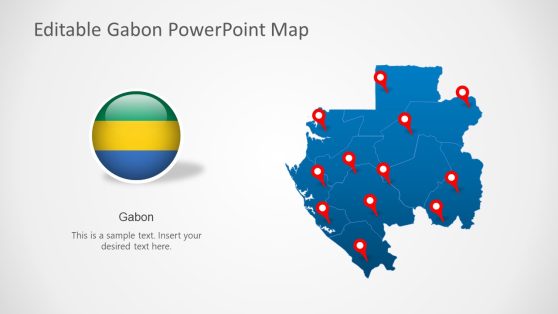
Editable Gabon PowerPoint Map
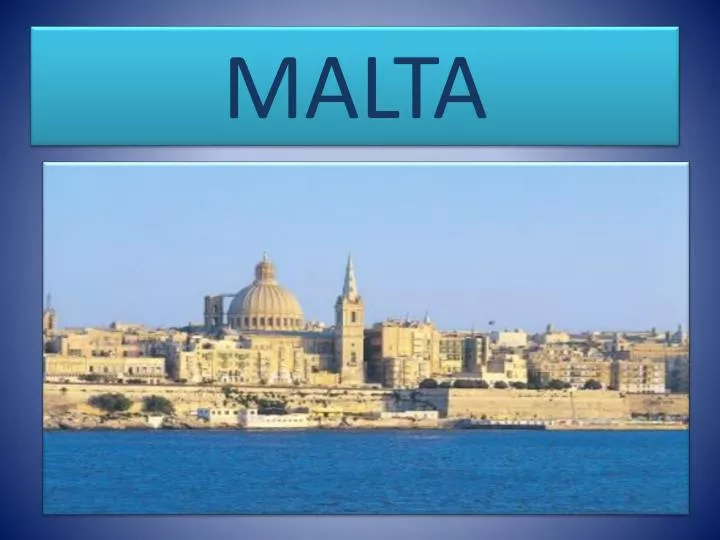
Sep 09, 2014
390 likes | 1.33k Views
MALTA. Malta is a Southern European country consisting of an archipelago situated in the centre of the Mediterranean , 93 km south of Sicily and 288 km east of Tunisia , with the Strait of Gibraltar 1,826 km to the west and Alexandria 1,510 km to the east. INFORMATION.
Share Presentation
- important islands
- 93 km south
- sites declared world heritage

Presentation Transcript
Malta is a Southern European country consisting of an archipelago situated in the centre of the Mediterranean, 93 km south of Sicily and 288 km east of Tunisia, with the Strait of Gibraltar 1,826 km to the west and Alexandria 1,510 km to the east
INFORMATION • THE CAPITAL OF MALTA IS VALETA • IT HAS ABOUT 400,000 INHABITANTS
IMPORTANT PLACES
There are eleven islands.Themostimportantislands are Comino , Malta and Gozo Malta Gozo Comino
There are threesitesdeclaredWorldHeritageby UNESCO: HypogeusHalSaflieni Megalithic Temples of Malta A Valeta
During Imnarja you can experience various old Maltese customs and traditions. http://www.youtube.com/watch?v=Knw3JkiFVUc&feature=fvst
- More by User

Malta. BUS 448c: International Strategic MNG Project 2: Corporation Research. Makhina Mirzoeva Olga Yeremenko. Natalya Amirova Rustem Ashyrov. Hennes&Mauritz family. presence . 48 markets. 3,000 stores. divisions . products. b rand competitors. $99. News. $27,692,280.
578 views • 34 slides
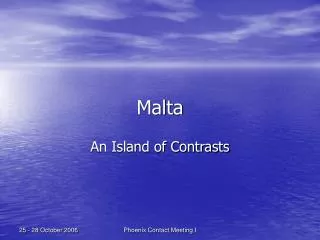
Malta. An Island of Contrasts. GOZO. MALTA. The Maltese Islands. The Maltese Islands. The total area is 316 km 2 Malta is 246 km 2 Gozo is 67 km 2 Comino is the small island between Malta and Gozo and has an area of 3 km 2 The total population is 400 000. VALLETTA. MDINA.
955 views • 27 slides

Malta. Presented By: Cierra Guasti Activity 6: Planning Your Dream Vacation May, 4 th , 2011. Click here to go to the next side. Climate of Malta. Malta’s climate is heavily influenced by the seas that surround them. Malta’s Summer Months are Hot and Dry with the temperatures reaching 31˚C.
871 views • 8 slides

Malta. History. Temple period: First inhabitants, built structures Run By several groups: The Phoenicians through the French. Current leader: British: Beat the French in a 2 year land-and-sea blockade. Tourist Attractions.
495 views • 5 slides

Malta. By. Christian lopez. Physical features. The physical features that you can expect from the places in Malta are these The land skape that you are seeing are the mouwtents in Malta The land scap is vary nice. Food and school.
360 views • 9 slides

Malta. April 2009. Hospitals & Institutions Public Relations / Public Information. PR / PI Panel. Institutions : Hospitals, IRC (Integrated Response Center), Parent’s Associations, Schools…… Local Community PR/PI Actions PR/PI Actions together with H&I. PR/PI. 12 Steps.
379 views • 17 slides

1.53k views • 28 slides

MALTA Situated squarely in the heart of the Mediterranean, the archipelago of the Maltese Islands is composed of three inhabited islands, Malta, Gozo and Comino.
397 views • 13 slides

Genova. Livorno. Barcelona. Civitavecchia. Istambul. Izmir. MX04. Palermo. Haifa. Malta. Status. On the 16 th December 2010, a BAROS station (IMEI 300034012390110, call sign BAREU51) was installed by ENEA and CNR-ISMAR La Spezia on board LA SUPERBA
242 views • 5 slides

Investigating ways to increase the efficient use of Electrical Energy in the Manufacturing Industry. MALTA. Energy Efficient Electric Motor Systems. Key Experts: Prof. Ing. C. Spiteri- Staines Co-Supervisors: Dr. Cedric Caruana Researcher: Mr. Peter Spiteri.
496 views • 24 slides

Malta. Malta. Comino. Gozo. Malta. Valletta. Der Großmeisterpalast ( Grand Master's Palace ). St Johns Co-Cathedral. Fort St. Elmo.
670 views • 15 slides

Malta. Hi my name is Odhrán mc Carron and here is my project which is about Malta !!!. The food in Malta.
488 views • 11 slides

MALTA. “A PLATFORM FOR DOING BUSINESS”. FINANCE MALTA PRESENTATION FEBRUARY 2005 KEVIN VALENZIA. MALTA - A PLATFORM FOR DOING BUSINESS. Financial services and related activities have been identified as being one of the three drivers of Malta’s economy
438 views • 28 slides

IMAGES
VIDEO
COMMENTS
Malta, island country located in the central Mediterranean Sea with close historical and cultural connections to both Europe and North Africa. Malta is about 58 miles (93 km) south of Sicily and 180 miles (290 km) from either Libya or Tunisia. The island achieved independence from British rule in 1964.
The Republic of Malta is a small country in the Mediterranean Sea (Southern Europe), is an EU (European Union) member state and consists of an archipelago of three islands: Malta (largest island), Gozo and Comino. This article will give you a primer that comprehensively covers the country of Malta, starting with the basics you need to know, followed by a section with traveller-focused ...
Malta Chanchai Bartz EDB 20 25.11.21 Berlin Srtucture Structure -Location,Geography and Climate -Flora and Fauna -Religion -History -Politics -Capital City -Sources Location, Geography and Climate Location, Geography and Climate -Area 316 km² -Highest point 253 m (Ta' Dmejrek) ... 70+ interesting psychology topics for presentation; Oct. 23 ...
🇲🇹 Malta - the island fortress at the heart of the Mediterranean. It has witnessed occupation by so many of history's great empires. And yet today it stand...
The Order of Knights of St John (also known as the Knights of Malta) ruled the islands from 1530 until 1798, during which period they built present-day capital city Valletta.(Learn more about Valletta's history here.The Knights improved living conditions across the Island building hospitals, stimulated trade and commerce and erected strong fortifications.
Malta Good to know Introduction 1. Dinner very late 2. Valletta, blue lagoon 3. Beautiful water to dive in - dangerous animals 4. Drivers are not careful 5. Always have cash 6. Do not drink the water We will talk about Tourism, Language, Food, Fashion, History and culture Tourism
Malta (/ ˈ m ɒ l t ə / ⓘ MOL-tə, / ˈ m ɔː l t ə / MAWL-tə, Maltese: [ˈmɐːltɐ]), officially the Republic of Malta, [14] is an island country in Southern Europe located in the Mediterranean Sea.It consists of an archipelago 80 km (50 mi) south of Italy, 284 km (176 mi) east of Tunisia, [15] and 333 km (207 mi) north of Libya. [16] [17] The two official languages are Maltese and ...
The Culture of Malta explained A mixture of societies of cultures over long centuries. The culture of Malta is the result of the many different societies that came in contact with the Maltese Islands throughout history, including cultures of neighbouring countries, cultures of nations that ruled Malta for long centuries, and other influences from tourism and media.
Presentation of Malta
Climate: -affected by the sea -characteristic Mediterranean flavor -hot and dry summers -short and wet autumns -cool and rainy winter -6 km nortwest -quiet and less traffic -mean temperature is 18 degrease Celsius -8km wide and 16 km long -ferry -Victoria Differences: -water
Elevate your presentations with high-quality statistical graphics, evocative images and a rich variety of content that reflects Malta's cultural and historical diversity. With our templates, every aspect of Malta becomes the main focus, ideal for sharing projects or narrating travel experiences.
This presentation is also suitable for those who have or want to propose business in Malta. For instance, pin mapping cities to display sales territories, business, office or franchise location, travel plans and much more. The main slide in the Malta PowerPoint Map Template shows a country chart with location pointers and round flag design ...
Malta is a Southern European country consisting of an archipelago situated in the centre of the Mediterranean , 93 km south of Sicily and 288 km east of Tunisia , with the Strait of Gibraltar 1,826 km to the west and Alexandria 1,510 km to the east. ... FINANCE MALTA PRESENTATION FEBRUARY 2005 KEVIN VALENZIA. MALTA - A PLATFORM FOR DOING ...
St. Johns Cathedrale (Valletta) Religion: 98% der maltesischen Bevölkerung sind römisch-katholisch die restlichen 2% sind Muslime. Die katholische Kirche hat großen Einfluss auf die maltesische Politik. Die Katholiken gehören zu den Bistümern Maltas. Der Katholizismus auf Malta